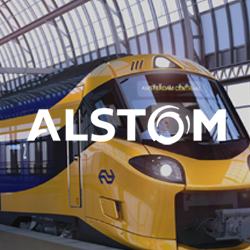
Transcript
To really save on cost when it comes to complex manufacturing, there are a lot of moving parts. You have to understand what your design should cost, what your suppliers should be able to make, and what your design engineers should investigate to remove cost outliers. Nobody understands these moving parts better than Alstom, a nearly century-old manufacturer of rolling stock: locomotives, trains, trams, and the infrastructure that goes with them. Alstom has accelerated their cost savings and time to market by using aPriori as a bridge between the cost engineering team and the design engineering organization. Today, I’m speaking with Vincent Bigot, the Director of Design to Cost at Alstom. Vincent is one of the key architects of Alstom’s dynamic strategy, which brings together the cost engineering team and the design engineering organization through shared data in aPriori. I started by asking Vincent Bigot to describe his role at Alstom and why moving in the right direction all begins with cost.
Vincent Bigot: I have a mechanical engineer background, but I quickly transitioned to procurement at Alstom. So I’ve spent 15 years in procurement, and there it was obvious how much the P&L, the profit and loss of a company was related to the costs. Now, what I’m doing today is supporting the operations. By operations, I mean engineering.
Leah Archibald: And I imagine your job has changed a lot since 1998. I imagine the tools have gotten smarter. Could you just give us a little bit of a picture of what cost analysis was like towards the beginning of your career versus what it’s like now?
Vincent Bigot: A lot has changed during this time period. In the hardware industry, we had a huge transformation of the sector. We used to be a sector that was very nationalized. It was very public transportation oriented with little competition. Now we have a situation where we are going into fierce competition with many players. They could be global players, they could be regional players. Now when you have a tender to be submitted, it’s very usual to have like five, six, or sometimes more bidders. So we have a huge competition in this market. But even the previous or the public-owned companies are more and more aggressive. So in terms of cost of ownership, this has been a dramatic change along the years.
Why is Cost Management so Important to Alstom?
Vincent Bigot: Practically speaking to us, the increased competition in the industry means that we need to improve the cost baseline. We need to improve the cost baseline by the day we submit the tender. But we also need to maintain that cost projection in the project execution. It is vital to keep the margin that we have forecasted.
The Drawbacks of Spreadsheets to Calculate Costs
Leah Archibald: I assume when you started at Alstom you were using spreadsheets to calculate costs.
Vincent Bigot: When we started, of course we started with spreadsheets. One of the drawbacks of the spreadsheet is as you have a growing community, it’s much more fragile. It’s much more difficult to share a spreadsheet. So if you want to have one community working with one tool, and if you want to increase the efficiency, getting rid of the spreadsheet is vital.
Use cases for aPriori at Alstom: From Procurement to then Design Engineering
Leah Archibald: When did you bring in aPriori to help everyone get on the same page?
Vincent Bigot: In 2015, we were interacting on the daily basis with the engineering deliverables, and we saw aPriori as a great chance to bring efficiency, because it was completely interacting with the 3D models.
The first thing we tried to do was to achieve some savings. So the easiest added value was to renegotiate some purchase orders using. We used the data from aPriori to support the renegotiation with subcontractors. This was an easy start. I mean, nothing is easy, but it was an easy first step because it doesn’t involve any fixed costs in terms of changing the design or optimizing the design. So first we turned to improving the negotiation.
Leah Archibald: So you started using aPriori to improve negotiation to get better costs from your suppliers. How did you transition from using aPriori only for procurement to decrease costs in supplier negotiations, to the using aPriori within design engineering to try to drive down your costs in the design process.
Vincent Bigot: It’s one thing to optimize the cost by the negotiation. It’s another thing to optimize the cost by the design. If you want to optimize the cost by the design, you need to understand what are the cost drivers. So we took all the analytics within the tool to see what were the main cost drivers, basically to help us to understand what we should tackle first. We had those first orientations on the analytics to bring our message to engineering to be more relevant, to be more effective.
From “Best Guess” to Data-Driven Design Improvements
Leah Archibald: What kind of results have you seen since you implemented aPriori to help cut costs within design?
Vincent Bigot: Often people speak with their own intuition or with their best guess. One of the results that we have seen is that from this best guess situation, we are coming to a more rational discussion based on data, based on analytics. So it’s less controversial because simply you are sharing data. You are sharing facts. It’s less opinions. It’s a matter of effectiveness.
I think the second reason we are successful is the people resources resources. Tolls are very important, but the way you use the tools is even more important. So you need people who are skilled. You need people who can talk on a bold manner to engineering. So we are investing a lot of resources to have people from an engineering background who we train to do costing.
Giving Design Engineers Cost Training Makes All the Difference
Vincent Bigot: I know that in some industries, there are people only doing costing, but we want people with a very good engineering background that we go and give them a cost background on top of this. This, in my opinion, makes an important difference.
As I told you, I have an engineer background. And for me, it’s fantastic combining the daily work of engineering together with cost. Because if you mix both, basically you are at the heart of many things and you have a very important link to success. You can drive the operations in a much more efficient manner.
I have been in procurement for a long time and it’s not always sustainable. Sometimes you negotiate, but you don’t know how much to push for. And sometimes you even push too much, so it’s not sustainable and it has a limit.
The procurement performance by the negotiation has a limit, which I have not found yet in the design. Because once you simplify a design, first it’s much more sustainable in terms of cost, but it also improves production easiness, manufacturability easiness, maintenance, energy consumption, CO2 impact. So it meets many positive impacts.





